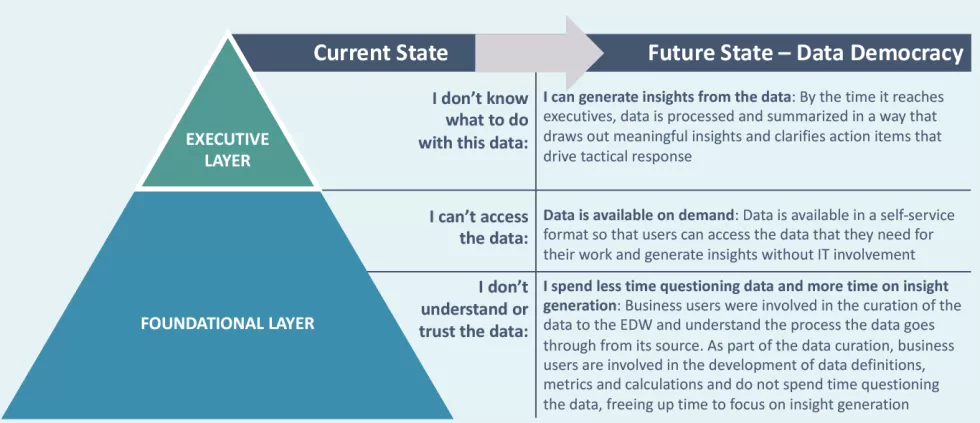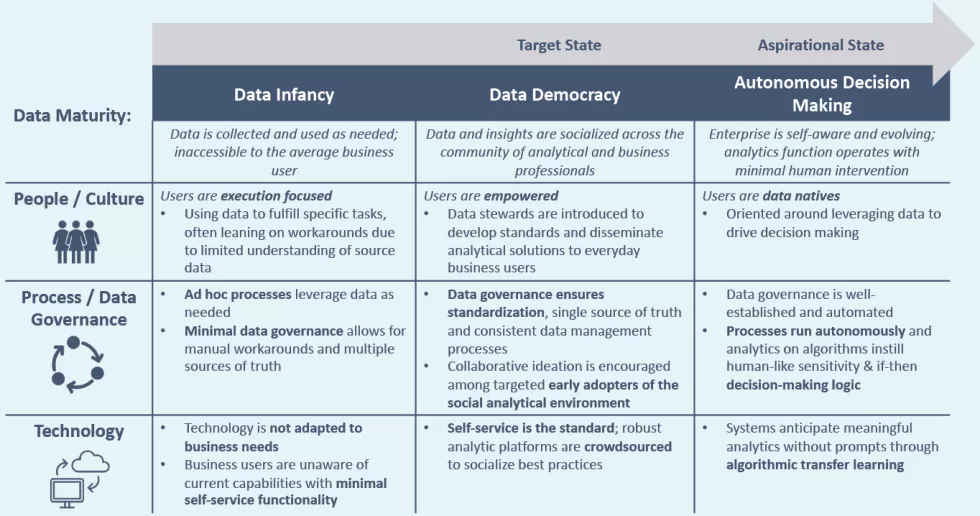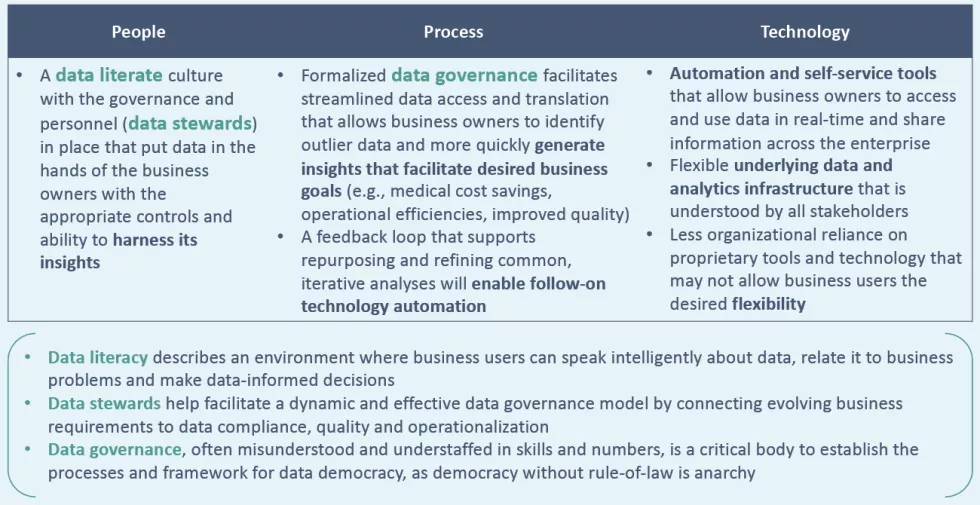Health plans are undergoing a transformation as they evolve their capabilities and business models to not only use data in new and innovative ways, but also cope with the increasing volume, variety and velocity of data. Given the impact COVID-19 has had on care delivery patterns, it has never been more important for health plans to access and quickly draw insights from available data across numerous business functions.
What is the issue?
Health plans have made significant investments to augment their data and analytic capabilities to generate more informed decisions with greater agility and accuracy; however, many plans report that they are not achieving this goal or the desired return on these investments.
Executive Thoughts
"I don't know what to do with this data"
The most common challenge we see in the market is that executives are presented an ever-increasing amount of data and reporting. While these reports contain a lot of information, it is very difficult to digest and translate this information into critical insights and understand the actions required from these findings.
"We have a wealth of information at our fingertips, but it's not digestible for the average user. It's not helping us make decisions."
-Health Plan CFO
Often underlying this executive frustration are operational data access, integrity and translation issues that limit business owners’ ability to synthesize data in a way that facilitates actionable insights to support organizational decision-making.
Business User Thoughts
"I can't access the data"
Business owners often find themselves searching for and struggling to synthesize data from disparate systems and sources. The data is collected but is not easily available to business users; for instance, “dark data” residing in locations outside the enterprise data warehouse (EDW) or lying “frozen” in data lakes. This fragmentation of data sources results in challenges accessing clean and timely datasets for analysis.
"I don't trust the data"
Many organizations face challenges during the data transfer from source to the EDW, resulting in loss of business insights and making the data unusable for end business users. As a result, business users will bypass the EDW and return to the source in order to perform their own transformations using desktop applications like excel. These actions result in “multiple versions of the truth”.
"I don't understand the data"
Business users that rely on and use data on a daily basis are often unclear of its source or what happens to the data before it gets to them. This fragmented understanding limits their ability to explain trends in the data or troubleshoot basic data issues and discrepancies.
How can health plans work through these challenges to achieve their analytic goals and realize a return on investment?
The solution is data democracy.
Health plans must create a culture in which data is in the hands of the entire organization, rather than only in the hands of IT and Analytics departments. The common misconception that managing data and using data are two separate functions leads to misalignment and misunderstanding. Data democracy creates the right linkages between business and IT users so that there is a comprehensive understanding of the data and how it was transformed. This, in turn, creates trust in the data and allows business functions to use data effectively. Without data democracy to drive trust, understanding and improved access, health plans will struggle to leverage analytics and IT investments to drive actionable insight that creates value and supports business decisions.
What does data democracy look like?
Data democracy mitigates the above-mentioned challenges, facilitating a richer and more efficient data experience for business users at all levels.
Figure 1: Future state of data democracy

How do we get there?
Creating the linkage between business and IT requires organizations to focus on supporting people and process changes necessary to curate, implement and sustain technology-enabled solutions.
Historically, investments have focused on the technology itself, but have not paid commensurate attention to the workforce (people) nor business processes to support these solutions. Without this focus, business users tend to revert to legacy processes that delay (or prevent) realization of IT investment.
With the people (roles, responsibilities and governance), process (controls) and technology (data infrastructure and tools) to manage data, a health plan can achieve a state of data democracy that empowers business users and executives to take a more hands-on approach to data and work collaboratively to tackle cross-functional issues.
The Data Maturity Framework below (see Figure 2) presents a model of data maturity that encompasses people, process and technology considerations. Plotting a health plan’s current state on this model allows it to evaluate and determine where it needs to focus its efforts to accelerate the journey to data democracy.
Figure 2: Data Maturity Framework

While most health plans are in the early stages of data maturity, this framework represents the incremental improvements across people, process and technology that advance the journey towards data democracy and beyond. As a byproduct of this effort, the evolution from data infancy to data democracy creates more interconnected people, processes and technology.
It is worth noting that a state of data democracy is a minimum foundation for the ultimate objective of the aspirational state, Autonomous Decision-Making. This aspirational state is governed by sophisticated, self-aware systems that intelligently and proactively anticipate data needs of their users. Ultimately, the data systems and platform curate the experience of business users and leaders, redirecting human focus away from aggregating and synthesizing information to allow time for strategizing based on data insights.
Conceptually, if a basic home thermostat represents data democracy, Autonomous Decision-Making is analogous to the Nest Smart Thermostat. While a thermostat responds to manual adjustments to room temperature, the Nest learns how people move around their homes and self-regulates settings to create comfort without sacrificing energy efficiency. In the same way, health plans that achieve Autonomous Decision-Making have automated, agile reporting that facilitates expedient insights because systems think on people’s behalf.
The aspirational idea of an enterprise system that thinks for itself or even a target state vision of “data in the hands of the people” can seem lofty. If infrastructure and change management requirements are applied successfully, they can lead to the following operational improvements:
Figure 3: Defining the success of infrastructure and change management requirements

Path Forward
"Health plans have not been able to convert substantial investments in data and analytics capabilities into value creation engines, largely because of gaps in how data is wielded by users and processes to derive insights and drive organizational decision-making. Health plans that want to unlock the potential of their investment must understand their position along the data maturity curve and pursue long-term strategies to incrementally close people, process, and technology gaps to evolve organizational culture and democratize data and analytics."
- Lee Stuck, Chief Analytics Officer, HealthScape Advisors
A critical component of this long-term strategy must include organization-wide data upskilling. As with any democratic state, with freedom comes accountability. Bringing data into the hands of business users must come with an expectation that these users have the skillset and data literacy to use and draw insights from it appropriately. While data governance and data stewards bring structure and controls to data processes, the individual interpretation and translation of data into insights is a skill that requires training and development. Organizations should promote these skillsets across all functional areas, not just in traditionally technology or analytics roles.
Health plans should also ensure their technology platform is aligned with data democracy; this involves determining the aptitude of current technology platform(s) to ingest all incoming data, convert it to a standardized, digestible format and interpret it to drive meaningful insights. Ensuring the right data is in the right platform will serve as a baseline for progress towards data democracy, ultimately paving the way for Autonomous Decision-Making.
Every health plan must have a tailored approach that accounts for enterprise priorities, infrastructure and capabilities in the development and execution of a sound data strategy. One tactic that has resonated with several of our clients involves leveraging interdisciplinary teams to solve end-to-end data-driven business problems. This team, inclusive of business users as well as IT and Analytics professionals is tasked with identification, evaluation and prioritization of a single business use case as the basis for a scalable solution. Through a series of shorter, digestible solution sprints, this team can help build the foundation for a data-driven culture that accelerates the organization towards data democracy. One recent example involved a client that focused on the accuracy of provider office information used by the risk adjustment team to contact providers for chart retrievals. While a limited use case, it represented a case study of how a cross-functional team of IT, analytics, and business owners (e.g., network, risk adjustment) worked together to understand the end-to-end data flow, align on common definitions and create an improved go-forward process with material return on investment (e.g., higher RAF scores, lower administrative cost for chart retrieval).
There is no “one size fits all” solution, and our experience suggests that organizational change can be a daunting undertaking. It is important to define a pathway that includes short-term milestones with an eye towards a longer-term, more aspirational state of using data—one that is delivered to the people, by the people, for the people.
HealthScape can help.
HealthScape can help health plans access and quickly draw insights from available data across numerous business functions. From insight to execution, HealthScape works with plans to address and create a better long-term strategy for utilizing your data.
Contact Alexis Levy and Lee Stuck for more information.




